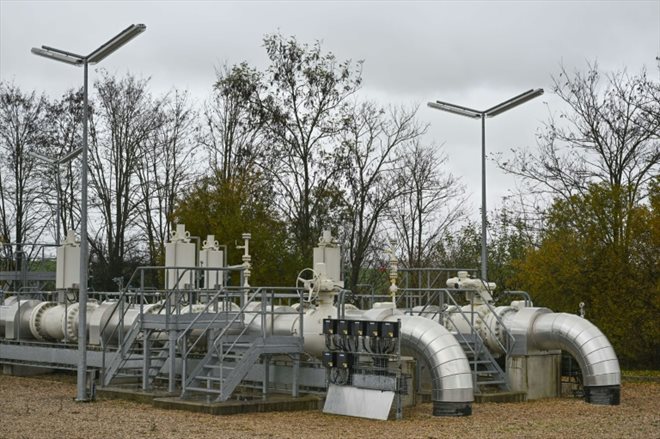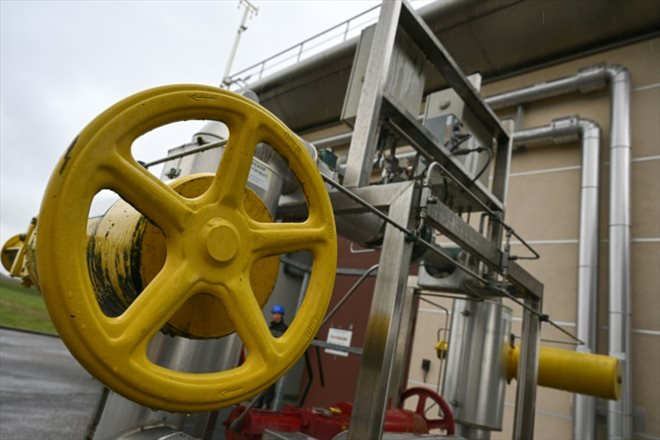The GRTgaz compressor station in Morelmaison in the Vosges on November 28, 2022 (AFP / SEBASTIEN BOZON)
Under the Vosges countryside, pipes to the rescue of Europe: near Vittel, the Morelmaison compressor station sucks up the gas arriving from Norway, Qatar or the United States to push it towards Europe and in particular the Germany as a winter almost without Russian gas begins.
At the heart of a bucolic landscape, this industrial site carries out a discreet but essential mission to transport gas to Europe, in particular to Germany, which was 55% dependent on Russia before the war in Ukraine.
On the surface, valves and pipes but little spectacular activity on this remotely controlled site, where only four people work.
The Morelmaison station is no less strategic: it provides the interconnection between a gas pipeline which brings gas, in particular from Norway, from Dunkirk to the north, another in the direction of Switzerland, a gas pipeline which historically brought from the northeast the Russian gas from Germany to the south of France.
There are 26 gas compression stations like those of Morelmaison distributed in France on the network of 32,527 km of pipes managed by the French gas transport manager GRTgaz.

The GRTgaz compressor station in Morelmaison in the Vosges on November 28, 2022 (AFP / SEBASTIEN BOZON)
They make it possible to interconnect the arteries which arrive and leave the station by a set of valves, but also thanks to turbines to raise the gas pressure to compensate for the losses caused during transport. “Raising the pressure allows the gas to be pushed into the pipes”, summarizes Guillaume Steschenko, deputy head of the compression department at GRTgaz, to AFP.
“The gas flows that pass through the station supply Germany, Switzerland and Belgium, and therefore allow (…) to show solidarity in a very concrete way and to compensate for the drop in flows from Russia” , underlines Guillaume Tuffigo, head of the marketing division at GRTgaz.
– Gas entrance door –
With the drying up of Russian gas in the pipes, Europe had to diversify its supplies, using Norwegian natural gas and liquefied natural gas from Qatar and the United States, which arrives by ship in four French LNG terminals running at full regime.
Long seen by gas companies as the “cul-de-sac” of Russian gas, France has paradoxically become one of the gateways for gas in Europe since gas from Moscow no longer arrives, or almost.
An idea “still unthinkable two years ago”, admits Thierry Found, CEO of GRTgaz. “We didn’t see too many reasons to think that this East-West flow could be called into question,” he adds. In the gas industry, didn’t they say that “Russian gas continued to arrive throughout the Cold War”?
Historically, gas arrived in France via Germany and Belgium to be consumed on the territory or redirected to Spain and Switzerland. But since the war, the gas highways and the direction of the pipes have been reversed. Concretely, France receives gas from Spain and “now the flows go from France to Belgium and Germany”, explains Guillaume Tuffigo.
France via the GRTgaz network multiplied gas transport to Switzerland by 7 in 2022 compared to 2021. At the same time, GRTgaz received 70% less gas from Germany in 2022 compared to 2021 (52 terawatt hours in 2021 and only 14 TWh in 2022).

The GRTgaz compressor station in Morelmaison in the Vosges on November 28, 2022 (AFP / SEBASTIEN BOZON)
Symbol of this historic reversal, France has been sending gas directly to its German neighbor since October 13, under a mutual aid agreement between the two countries.
On November 22, 2.7 TWh of gas – the equivalent of what three nuclear reactors would supply – were sent to Germany via the gas border post of Obergailbach (Moselle), a site prohibited to the visit, himself connected to Morelmaison. France is making available a transmission capacity of 100 GWh/day, the maximum technically possible at this stage.
For now, Europe, whose stocks are full (at 93% on Wednesday), is going without Russian gas pipelines, but for how long? “While waiting for new liquefied gas production capacities, it will still be tricky for five years,” predicts Mr. Trouvé.
© 2022 AFP
Did you like this article ? Share it with your friends with the buttons below.




